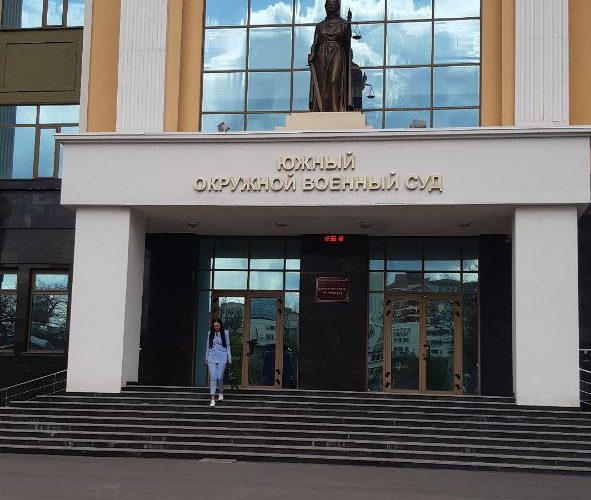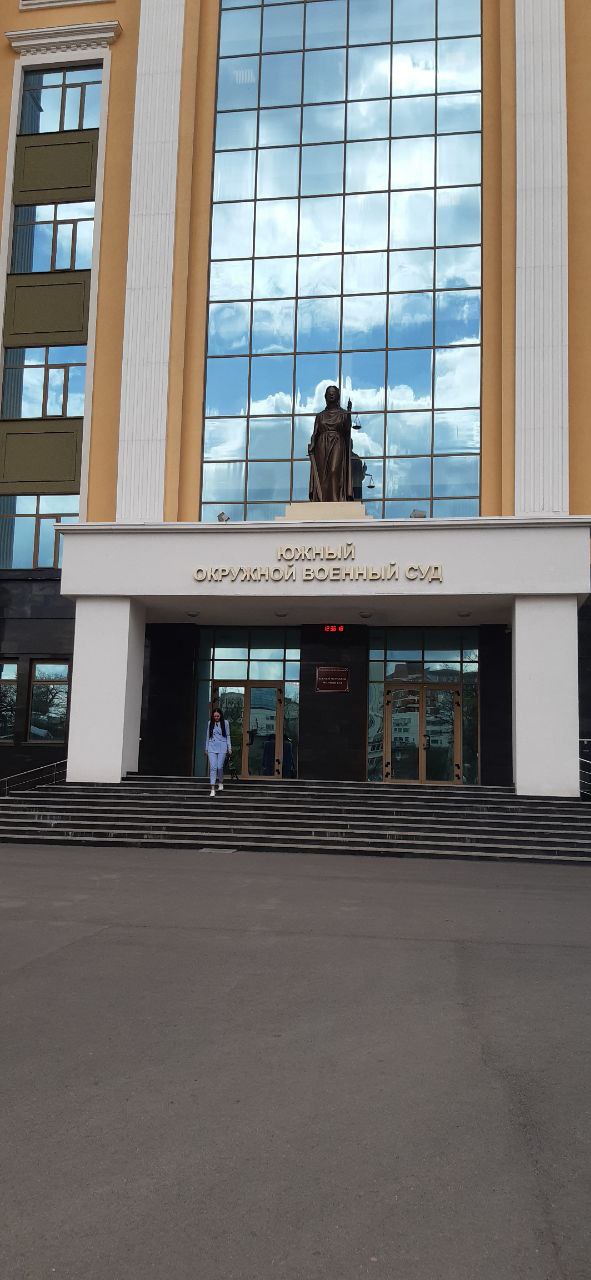

About the case: Anton Vladimirovich Cherednyk, a member of the Ukrainian Armed Forces, is accused under Article 278 of the Criminal Code for ‘violent seizure of power,’ Part 1 of Article 356 for ‘cruel treatment of the civilian population, using prohibited means and methods in an armed conflict,’ Part 2 of Article 105 for ‘murder,’ and Article 205.3 of the Criminal Code of the Russian Federation for ‘training for terrorist activities.’ According to the investigative committee, Cherednyk shot a peaceful civilian for incorrectly pronouncing a phrase in the Ukrainian language.
The case is being heard by a panel consisting of: presiding judge Vyacheslav Alexeyevich Korsakov, Ilya Nikolaevich Bezgub, and Mukhamed Khasanbievich Kilyarovthe of Southern District Military Court.
Besides the lawyer and the prosecutor (this time Sergey Vladimirovich Aydinov, as explained by the secretary, is leading this case, the female prosecutor in the previous session was merely standing in for him), there are 5 representatives from the media (Zvezda, RIA Novosti, TASS, AiF.ru), and some observers present.
The secretary invited the lawyer to enter the room 10 minutes earlier. The rest were allowed in around 11:05. The session started around 11:16 (scheduled for 11:00). The court requested the secretary to report the reason for the delayed start.
Secretary: “The reasons are technical, related to the court’s video conferencing system.”
The court inquired about the parties’ connection to the court’s video conferencing system with the Donetsk Military Court.
Lawyer, prosecutor: “No objections.”
Court: “Ensure the victim’s participation via the video conferencing system. There has been a substitution of the state prosecutor in this hearing. The parties are informed about their right to challenge.”
Lawyer: “No challenges.”
Prosecutor: “No challenges, no motions either.”
The court addresses the video conferencing system to establish the identity of the person present at the Donetsk Garrison Military Court. The victim, Sergey Vitalievich Potselyuev, appeared. He has difficulty hearing Rostov’s side, and the judges can’t see him clearly (he stands in the center of the room, presumably in front of the court podium). The court requested him to come closer to the camera, so he was repositioned behind a desk and the camera got adjusted. The court asks questions (when asked about his nationality, the victim hesitated, stretched to the side, and uncertainly responded ‘former Ukrainian‘).
Court to the victim: “Did you file a civil lawsuit?” (Answer: “No”), “Are you familiar with the case materials?” (Answer: “Yes”), “Are you acquainted with Cherednyk?” (Answer: “No”).
The judge then explained the victim’s rights and ensured the rights were understood.
Judge to the Donetsk Military Court employee: “Has the identity been confirmed?” (Answer: “Yes”). “Please formalize the acknowledgement of rights.” (“Alright”).
Subsequently, the court listed the participants present at the Southern District Military Court for the victim, then explained the right to challenge. There were no challenges.
Court to the prosecutor: “Do you request an interrogation?”
Prosecutor (eagerly): “Yes.”
Court to the lawyer: “Do you object?”
Lawyer: “No, we don’t object.”
Prosecutor to the victim: “Can you hear me well?”
The victim didn’t respond. They tried adjusting the judge’s microphone (the only one for all participants), accidentally dropping it. The secretary lifted it, explaining the difficulty of moving it due to both the camera and the microphone being attached to it. Eventually, the prosecutor approached the judges’ podium and asked questions from there.
Prosecutor to the victim: “Tell us about the events of March 27, 2022.”
Victim: “Piskunov and I were heading home when we were stopped by Ukrainian Armed Forces soldiers.”
Prosecutor: “How did you understand that?”
Victim: “By their attire.”
The victim then describes roughly the following:
– One wore a mask, the other did not. The one without the mask/balaclava had gray hair, was two meters tall, they stopped us, started shooting into the air. The one without headgear gave orders, commanded us to lie down, we lay on our stomachs, then, by command, we turned over. He fired twice near my head…
After another clarifying question from the prosecutor, the judge interrupted, asking why they were “digging so far back” as the accused had already been identified in the case.
Judge to the victim: “Do you see Cherednyk?”
The victim requests a closer look.
There’s some commotion again, and ultimately, the judge instructs Cherednyk to move to the middle of the room. Eventually, the victim identifies the defendant: “Yes, that’s the one I described.”
The victim continues the narrative:
– We were stripped. That one took Piskunov aside, asked him something, then shot him twice in the torso. They were facing each other. The shot hit him in the chest area. And I got shot near the head while we were lying down.
Prosecutor: “Did you participate in investigative procedures?”
Victim: “I was involved in the ‘identification’ investigative action.”
– Why were you stopped?
– I don’t know, we were just walking along the street (mentions the intersection). On March 28, the next day, they buried him not far from there. I have a scar to the right of my mouth, where the rifle barrel was pressed.”
– Will you file a civil lawsuit?
– No.
The court suggested asking questions from the defense.
Lawyer: “Clarify the time of day this occurred.”
Victim: “6:30 PM, sunset [and further responses to the lawyer’s clarifying questions], there was no lighting, no other people around, I personally participated in Piskunov’s funeral.”
Judge to Cherednyk: “You may also ask questions.”
Cherednyk: “I have no questions.”
Judge to the victim: “Will you continue to participate in the proceedings?”
Victim: “No.”
Judge to the prosecutor: “Do you wish to present evidence in the presence of the victim?”
The prosecutor discloses the identification protocol from a photograph and the on-site testimonial verification protocol.
The court poses questions to the victim: “Nationality?” (“Ukrainian”), “where were you heading?” (“home”), “where do you work?” (“Before [ROSKOMNADZOR] I used to work at a plant, after [ROSKOMNADZOR] began – nowhere”), “will you participate further?” (“I won’t”).
(In Russia it’s potentially dangerous to use word “war” for Russia-Ukraine conflict, it may follow with criminal case, so we change it for different ones, like “[ROSKOMNADZOR]” – because of government body that is responsible for monitoring Internet sites for certain violations).
The victim is dismissed, the proceedings via video conferencing are concluded.
Judge to the prosecutor: “What further evidence do you have?”
The prosecutor requests to consider and attach a note from Svetlana Fedorovna Semykina (the deceased’s mother), in which she requests to be excluded from the list of victims; a note from Alexandra Ivanovna Klimenko (the deceased’s grandmother), stating her refusal to attend the court and requesting the disclosure of the statements she provided during the investigation; as well as notes from the witnesses Kostrominykh (relatives: mother and son), who also decline to appear in Rostov-on-Don.
Judge to the lawyer: “What’s your opinion regarding Semykina’s exclusion?”
Lawyer: “I need to discuss this with the defendant; we haven’t talked about this matter.”
Judge: “Discuss it.”
The lawyer hesitated for a moment (apparently not immediately realizing he was being asked to discuss it here and now), then silently stood up from his seat, approached the defendant, and began speaking quietly with Cherednyk.
Lawyer: “We have no objection to Semykina’s exclusion; we agree to disclose Klimenko’s statements but request the witnesses to be questioned during the session.”
The court excludes Semykina from the list of victims and orders the disclosure of Klimenko’s statements; rejects the request to disclose the witnesses’ statements; and includes the notes.
The prosecutor requests the third volume of the case to disclose Klimenko’s statements. He discloses two interrogation protocols (from which we learn that the body was buried near the old post office, and the deceased was born in 1990).
The prosecutor informs the judge that he has prepared a list of evidence to be presented for examination.
The court explains the defense’s right to challenge any evidence at any point during the trial.
Then, the prosecutor discloses the case materials, specifically: inspection reports of items, autopsies, examination of internet resources (about the “Desna” training center), examination of a birth certificate, examination of an internet page (about the 502 battalion of the Ukrainian Armed Forces), examination of video material (a YouTube video where Cherednyk discusses the deceased’s inability to answer the question “what is ‘palianytsia'”), and a psychiatrist’s report.
Before disclosing the psychiatrist’s report, the court asks the lawyer if he objects to its disclosure in the open session — the lawyer doesn’t object.
The prosecutor discloses the report on the deceased’s injuries, then the report on Pozyelyev’s injuries, followed by Cherednyk’s profile.
Prosecutor to the court: “That’s everything according to the case materials.”
The court inquires about what the prosecution will present next time.
Prosecutor: “Testimony from three witnesses, also via video conferencing.”
Court to the defense: “And you?”
Lawyer: “We have no witnesses, nothing to disclose.”
Cherednyk: “I request a health report.“
Court to Cherednyk: “Are there doctors in the detention center? Address them. You’re there; they will provide it. As per your request, you may do it verbally.”
Cherednyk (clarifying the court’s stance and whether he had previously approached the detention center about this health issue): “My vision is deteriorating. I haven’t sought help in the detention conditions.”
Court to the lawyer: “Explain how to do this. Address them yourself.”
Lawyer: “I inquired. The detention center administration says a court request is needed.”
Court to Cherednyk: “Anton Vladimirovich, just address them. If they don’t respond, then the court.”
Cherednyk (voicing health complaints): “Vision, heart, legs failing; previously sought help for the heart issue.”
Court: “Alright, phrase it, address them yourself first, then the court. The next session is on May 15 at 10:00.”
Court to the prosecutor: “If there’s a request for video conferencing, we’ll set it immediately.”
Prosecutor: “Yes, one place — Donetsk Military Court, plus we’ll clarify for the third witness.”
Lawyer: “We have no objections.”
Court: “Schedule the video conferencing; the prosecution will ensure the witnesses’ availability.”
Court to the lawyer: “Ensure the receipt of medical data.”
© 2019-2021 Independent public portal on impartial trial monitoring
